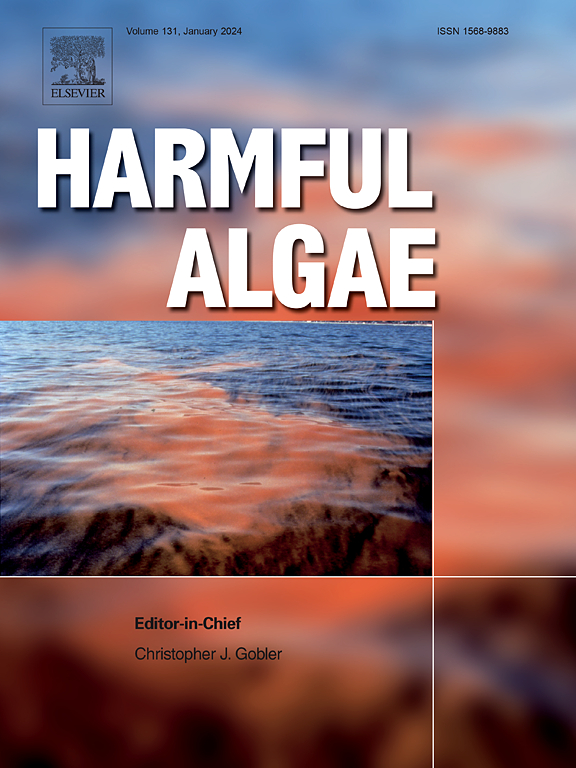Toxicity and toxin profile of La Réunion (Indian Ocean) fish containing CTX-like compounds
IF 4.5
1区 生物学
Q1 MARINE & FRESHWATER BIOLOGY
引用次数: 0
Abstract
Several outbreaks of ciguatera poisoning have been recorded in La Réunion (SW Indian Ocean) since 1986. Toxicities and toxin profiles of fish from the Indian Ocean are poorly documented. In this work, a multidisciplinary study on the toxicity of fish from the Indian Ocean by neuro-2a cell-based assay was assessed, and the CTX-like compounds were evaluated by a magnetic bead-based immunoassay. The toxin profile is described by liquid chromatography coupled to tandem mass spectrometry and high-resolution mass spectrometry. The liver, muscle, and viscera of four fish specimens of three different species (one Lutjanus bohar, two Variola louti and one Carcharinus leucas) caught in the waters of La Réunion were analysed. One of the V. louti specimens was obtained after a CP incident. Their toxicity values ranged between 0.01 and 2.69 μg CTX1B equiv.·kg-1 in flesh, 1.60 and 6.50 μg CTX1B equiv.·kg-1 in liver and 0.07 and 4.77 μg CTX1B equiv.·kg-1 in viscera. In general, liver and viscera showed higher concentrations of CTX-like compounds than flesh. Several potential CTX congeners were identified. LC-MS/MS confirmed the presence of CTX1B, 52-epi-54-deoxyCTX1B and 54-deoxyCTX1B in the flesh of the V. louti specimen involved in the CP incident. CTX1B was identified in the three tissues of the other V. louti individual and in the L. bohar. The C. leucas samples revealed the presence of a complex CTXs profile showing congeners of the CTX3C-group. The strategy used within this research work could be a valuable tool for future food safety monitoring in the Indian Ocean area.

含有ctx样化合物的La r(印度洋)鱼的毒性和毒素谱
自1986年以来,在拉西乌姆(西南印度洋)发生了几起雪卡毒素中毒事件。关于印度洋鱼类的毒性和毒素谱的记录很少。在这项工作中,通过基于神经2a细胞的检测对印度洋鱼类的毒性进行了多学科研究,并通过基于磁珠的免疫检测对ctx样化合物进行了评估。毒素谱由液相色谱耦合串联质谱和高分辨率质谱描述。分析了在La r水域捕获的三种不同种类(一种Lutjanus bohar,两种varola louti和一种Carcharinus leucas)的四种鱼的肝脏、肌肉和内脏。一个V. louti标本是在CP事件后获得的。对肉的毒性值为0.01 ~ 2.69 μg CTX1B当量·kg-1,对肝脏的毒性值为1.60 ~ 6.50 μg CTX1B当量·kg-1,对脏器的毒性值为0.07 ~ 4.77 μg CTX1B当量·kg-1。总体而言,肝脏和内脏中ctx样化合物的浓度高于肉。确定了几个潜在的CTX同源物。LC-MS/MS证实在CP事件中涉及的V. louti标本的肉中存在CTX1B, 52-epi-54-deoxyCTX1B和54-deoxyCTX1B。CTX1B分别在其他V. louti个体的3个组织和L. bohar中被鉴定出来。C. leucas样品揭示了一个复杂的CTXs剖面的存在,显示了ctx3c群的同系物。这项研究工作中使用的策略可能是未来印度洋地区食品安全监测的宝贵工具。
本文章由计算机程序翻译,如有差异,请以英文原文为准。
求助全文
约1分钟内获得全文
求助全文
来源期刊

Harmful Algae
生物-海洋与淡水生物学
CiteScore
12.50
自引率
15.20%
发文量
122
审稿时长
7.5 months
期刊介绍:
This journal provides a forum to promote knowledge of harmful microalgae and macroalgae, including cyanobacteria, as well as monitoring, management and control of these organisms.
 求助内容:
求助内容: 应助结果提醒方式:
应助结果提醒方式:


